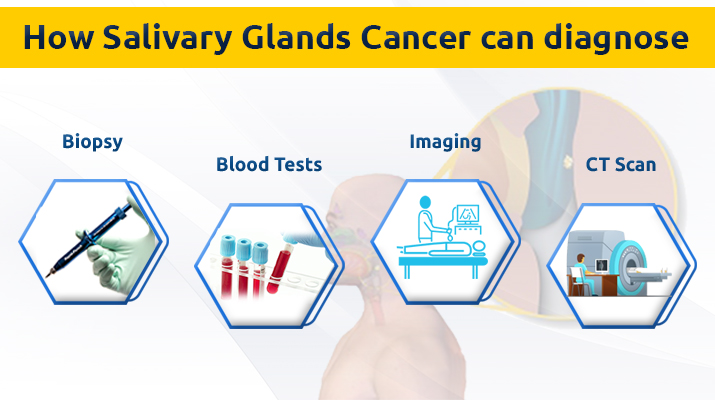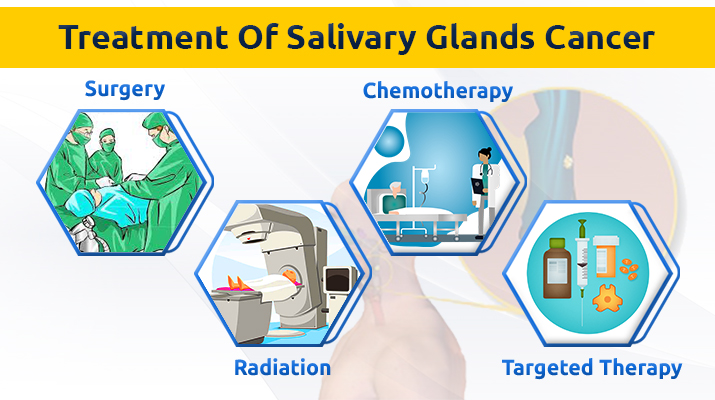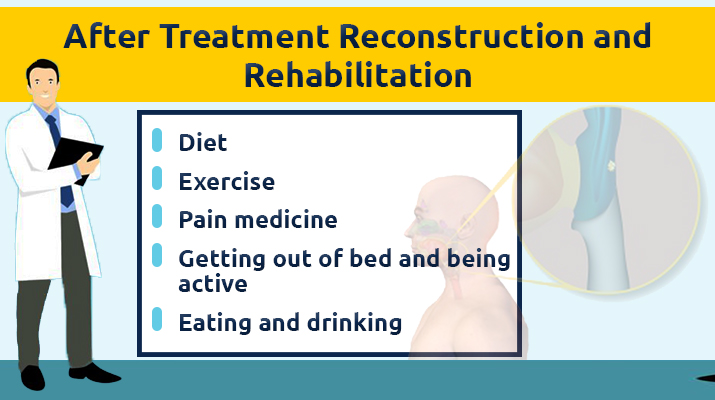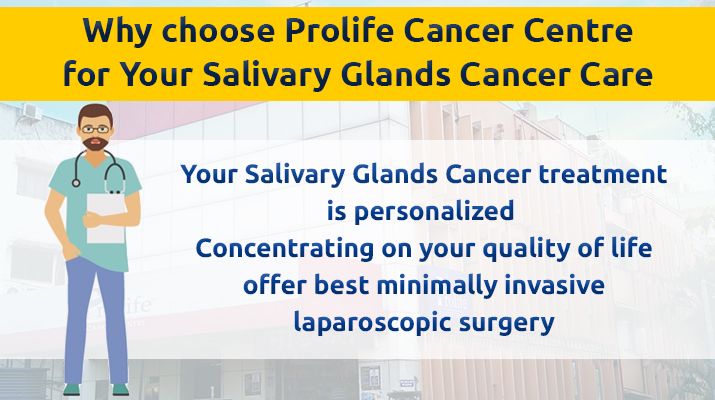What is Salivary Glands Cancer?
Salivary glands produce saliva, which keeps the mouth moist and helps the body with digestion.
The mouth contains many salivary glands, some major and some minor. Salivary gland cancer occurs when one of these glands develops a cancerous tumor. There are 450-750 microscopic minor salivary glands all around the mouth. Locations include: the sinuses, the tongue, inside the cheeks, the nose, the larynx and voice box.
Tumors are less likely to occur in these minor glands, but if one does develop, there is a 50-50 chance that it will be cancerous, or malignant.
- Parotid glands: These are the largest salivary glands. About 70% of salivary gland tumors start here. Most of the time, they’re harmless.
- Submandibular glands: These are located beneath the jaw. About 15% of salivary gland tumors start here. Nearly all of them turn out to be cancerous.
- Sublingual glands: These are located below the tongue. It’s unusual for a tumor to start here.
Most often, cancers of the minor salivary glands start in the roof of the mouth.
Salivary Glands Cancer Risk Factors
- They most commonly occur in older adults.
- Radiation used to treat head and neck cancers, increases the risk of salivary gland tumors.
- People who work with certain substances may have an increased risk of salivary gland tumors. Jobs associated with salivary gland tumors include those involved in rubber manufacturing, asbestos mining and plumbing.
Salivary Glands Cancer Risk Factors
- A block or lump on or near your jaw or in your neck or mouth
- Paralysis in part of your face
- Muscle dizziness on one side of your face
- Persistent pain in the area of a salivary gland
- Difficulty while eating
- Difficulty while opening your mouth widely
Signs of Salivary Glands Cancer may include:
- A lump (painless many times) in the area of the ear, cheek, jaw, lip, or inside the mouth.
- Trouble swallowing or opening the mouth widely
- Fluid draining from the ear.
- Numbness or weakness in the face.
- Pain in the face that does not go away.
These signs usually do not mean you have Salivary Glands Cancer. But if you see one or more of them for more than two weeks, consult your doctor.
Book Appointment
Quick Contact
- Address 557A1/15C Gultekadi, Market Yard Pune, Maharashtra 411037
- Email social.prolife@gmail.com
- Phone +91-9607079019, +91-9607079029
How can it be diagnosed?

Diagnosis is typically carried out by the following procedures or tests:
- Biopsy: Tissue biopsy is used from any suspicious region. A tiny piece of tissue is removed with a special tool passed through the scope. The sample is sent to the pathology lab for examination by a pathologist who looks for cancer cells in the specimen.
- Genetic tests may also be done on the biopsy specimens to recognize specific gene mutations in the cancer cells. These examinations are available at very few centers in the country.
- CT or CAT (computed axial tomography) scan
- MRI (magnetic resonance imaging) scan
- PET/CT (positron emission tomography) scan
- Virtual colonoscopy or CT (computed tomography) colonoscopy
- Double-contrast barium enema (DCBE): Barium is a chemical that provides the bowel wall to show up on an X-ray. A barium solution is given by enema, and then a set of X-rays is taken.
- Blood test for carcinoembryonic antigen (CEA): CEA is a protein, or tumor marker, made by some harmful tumors. This examination also can be used to see out if the tumor is developing or has come back after treatment.
Stages of Salivary Glands Cancer
Stage I:
Tumors are very small (less than 2 centimeters across), and they don’t spread to other parts of the body.
Stage II:
Cancers are a little bigger (between 2 and 4 cm) but still in the original gland.
Stage III:
Cancer have moved out of the gland, possibly to the lymph nodes in the same side of the neck.
Stage IV:
Cancer have spread to the lymph nodes and maybe other parts of the body.
What are the treatment options for Salivary Glands Cancer?

Your Salivary cancer treatment at Prolife may include one or more of the following therapies:
- Surgery
Surgery is the most usual treatment for colon cancer, especially if it has not developed. As for many cancers, surgery for colon cancer is most successful when done by a surgeon with a great deal of knowledge in the procedure.
- Chemotherapy
Prolife offers the most up-to-date and effective chemotherapy choices for Salivary Glands Cancer. Drugs are given by mouth or intravenously
- Targeted therapy
Targeted therapy targets cancer’s specific genes, proteins, or the tissue conditions that add to cancer growth and survival. Targeted therapy blocks the increase and spread of cancer cells while restricting the damage to normal cells.
- Radiation therapy
Radiation therapy uses strong energy sources, such as X-rays and protons, to kill cancer cells. It might be used to withdraw large cancer before an operation so that it can be removed more quickly.
When surgery isn’t an option, radiation therapy might be used to reduce signs, such as pain. Sometimes radiation is mixed with chemotherapy.
After Treatment: Reconstruction and Rehabilitation

Healing from Surgery
Most people who have Salivary cancer surgery heal without any problems. These people go home within 2-to-4 days. A fewer number of patients may have a slower recovery and need to wait for a little more.
A surgeon will give you guidance on how to take care of yourself, including your surgery, bathing, driving, and sexual activity. There will be information about yourself:
- Diet
- Muscle Exercise
- Pain medicine
- Bowel movements
After Treatment, you will be given a Daily Goals Checklist. Use that checklist to understand how you are doing every day.
Your Daily Goals Checklist
While you are in the hospital, you will have regular aims to help you recover. These aims include:
- Getting out of bed and being active
- Eating and drinking
- Controlling your pain
Follow-up appointments

After you’ve completed your treatments for Salivary Glands Cancer, follow-up care is very essential. Routine checkups can help find any changes in your health, and if cancer comes back (or “recurs”), it can be treated as soon as possible.
If your treatment has finished, follow-up appointments maybe every 3−6 months for the first couple of years and 6−12 months for the following 3 years.
Your doctor may check your CEA level before you begin treatment and again after treatment to understand if it has come down. Many doctors suggest a colonoscopy test within 6 months after Salivary Glands Cancer surgery.
Doctors recommend CT scans of the chest, abdomen, and pelvis n a daily schedule for 3 years in people who are at high risk for recurrence.
Why choose Prolife Cancer Centre for Your Ovarian Cancer Care?

At Prolife Cancer Center, your ovarian cancer treatment is personalized to give the best results, while concentrating on your quality of life. We offer minimally invasive laparoscopic surgeries that provide successful treatment with less impact on you.
At Prolife Cancer Center, your Salivary Glands cancer treatment is personalized to give the best results, while concentrating on your quality of life. We offer minimally invasive laparoscopic surgeries that provide successful treatment with less impact on you.
Specialized Ovarian Cancer Treatments
Prolife offers unique options. Our globally renowned team of physicians shows your treatment for the most benefit while reducing the impact on your body.
Dr. Sumit Shah is expertise in treating ovarian cancer. We offer the best Laparoscopic surgery treatment for Salivary Glands cancer also chemotherapy and targeted therapy options.

